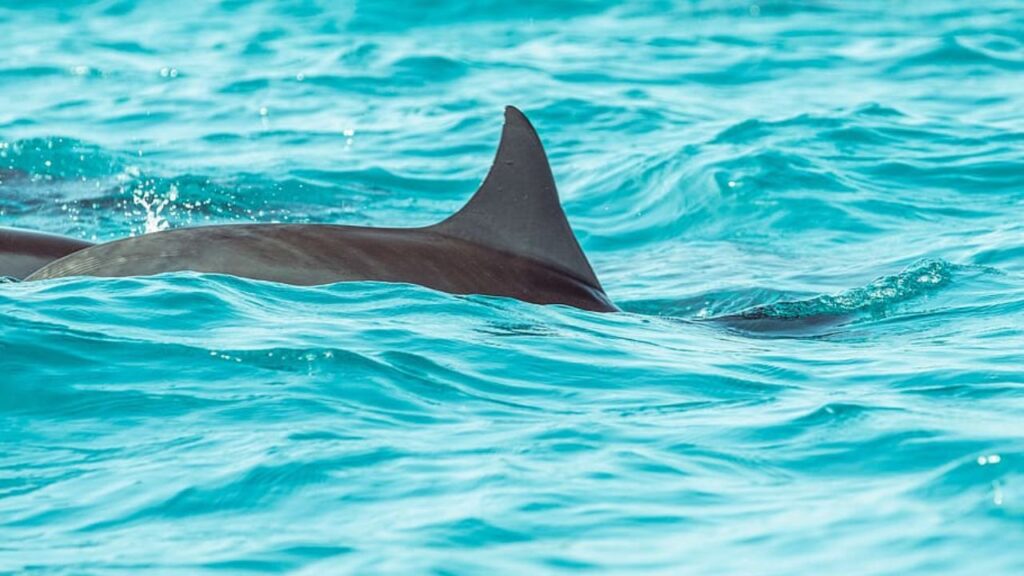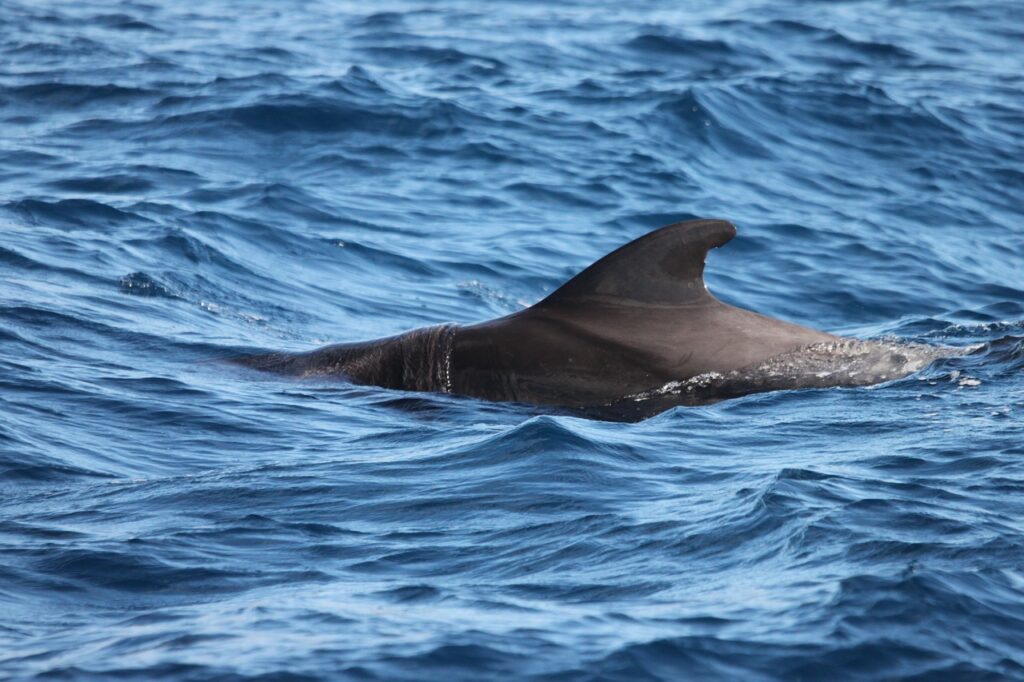
Do All Dolphins Have Fins? Yes, all dolphins have fins. Fins are essential anatomical features that aid in swimming and maneuverability for dolphins.
Are you looking to explore the fascinating world of dolphins? These intelligent marine mammals are renowned for their social behavior and sleek aquatic abilities.
One of their defining features is their fins, integral for their locomotion and survival in the water. But do all dolphins possess fins? Let’s delve into this inquiry and unravel the intricacies of their anatomy.
Table of Contents
Anatomy of Dolphin Fins
Dolphin fins are specialized appendages that have evolved over millions of years to suit their marine lifestyle.
There are several types of fins found on dolphins, each serving a specific purpose:
Dorsal Fin
The dorsal fin is a prominent feature that extends vertically from the dolphin’s back. It serves multiple functions, including:
Stabilization: The dorsal fin acts as a stabilizer, helping the dolphin maintain balance while swimming. It prevents excessive rolling and provides hydrodynamic stability.
Thermoregulation: In some species, the dorsal fin contains a dense network of blood vessels, which helps regulate body temperature by dissipating excess heat.
Communication: The dorsal fin may also play a role in communication and signaling within dolphin groups, as it is easily visible above the water’s surface.
The size and shape of the dorsal fin can vary among different dolphin species. [Do All Dolphins Have Fins?]
For example, larger species like the killer whale (orca) have tall, triangular dorsal fins, while smaller species like the common dolphin have smaller, more curved dorsal fins.
See Also: Does Dolphin Have Ears? How Do Dolphins Hear?

Pectoral Fins
The pectoral fins, which are located on either side of the dolphin’s body, resemble bat or bird wings. These fins are adaptable structures that serve a number of crucial purposes:
Maneuvrability: In order to steer, turn, and retain equilibrium during difficult maneuvers, pectoral fins are essential. [Do All Dolphins Have Fins?]
They give the dolphins precise control over their movements, enabling them to avoid impediments and maneuver through confined locations.
Communication and Social Interaction: Pectoral fins are involved in social interactions and communication as well as dolphin behavior overall.
They are frequently employed in both subdued touches and gestures during social bonding activities as well as in aggressive or dominant displays.
Hydrodynamic Efficiency: The dolphin’s hydrodynamic efficiency is enhanced by the flexibility and form of its pectoral fins, which lower drag and enhance swimming ability.
See Also: Does A Dolphin Have Eyes? Unveiling the Hidden Wonders
Fluke
Dolphins have a horizontal tail fin at the end of their tailstock that is called the fluke. It is a strong structure that provides acceleration and propulsion, allowing dolphins to move quickly through the water. The fluke’s main attributes and capabilities include:
Propulsion: The fluke uses vertical motions called fluke beats to provide push and forward motion. The dolphin moves ahead with amazing speed and agility because to the water currents created by these motions.
Energy Efficiency: Dolphins may travel great distances using little energy because the fluke is made to be as efficient as possible. [Do All Dolphins Have Fins?]
Because of its streamlined design and flexible tissue, it maximizes the translation of muscle energy into forward motion while minimizing drag.
Communication: Like other fins, the fluke may also have a communicative function, as its movements and position can convey information to other dolphins.

Anal Fin
The dolphin’s anal fin is a tiny, triangular feature that is situated close to its tail. The anal fin, however less noticeable than the dorsal fin, may have multiple purposes.
Stability: The anal fin can help with balance and stability during swimming, particularly when turning quickly or swimming at a high speed.
Hydrodynamic Effects: The anal fin is thought to provide hydrodynamic effects that help with propulsion and maneuverability, although being less studied than other fin species.
Sensory Function: Although further research is required to establish this, some researchers theorize that the anal fin may have touch or sensory receptors.
See Also: Do Dolphins Have Tongues? Exploring the Mysteries
Do All Dolphins Have Fins?
Yes, indeed, all dolphins possess fins, which are fundamental anatomical structures crucial for their survival and functionality in aquatic environments.
Although the fins of different dolphin species vary in size, shape, and arrangement, they are a common characteristic of the Delphinidae family. Taking a closer look at the role fins play in a dolphin’s physiology
Dorsal Fin: Probably the most identifiable, the dorsal fin is located on top of the dolphin’s back. Although the exact dimensions and form differ between species, its main purpose is to support balance and stability when swimming.
When swimming through the water, dolphins need this fin to help them keep their balance and posture. [Do All Dolphins Have Fins?]
Pectoral Fins: Similar to a bird’s wings, the pectoral fins are located on either side of the dolphin’s body.
These fins can be used for a variety of tasks, including steering, maneuvering, and even interacting with others.
Dolphins use their pectoral fins for displays and precise motions, but they also use them for communication.

Fluke: Dolphins use their fluke, which is situated at the tip of their tail, as their primary source of propulsion.
Because of its horizontal posture, the dolphin’s muscle contractions provide strong thrusts that enable effective forward mobility.
For accelerating, sustaining speed, and maneuvering through a variety of aquatic situations, this fin is essential.
Anal Fin: Though smaller and less conspicuous, the anal fin is nonetheless present in dolphins.
Positioned near the tail, its exact function is still under investigation, but it likely contributes to stability and hydrodynamic efficiency during swimming.
See Also: Do Dolphins Have Limbs? Discover the Fascinating Truth
Evolutionary Adaptations
Dolphins’ amazing adaption to aquatic life is fascinatingly demonstrated by the evolution of their fins. [Do All Dolphins Have Fins?]
The evidence from fossil records is strong, suggesting that the earliest relatives of dolphins were terrestrial mammals who over millions of years adopted an aquatic existence.
Their limbs saw major changes during this evolutionary voyage, eventually developing into the fins we see today. Here’s a closer look at dolphin fins’ evolutionary adaptations:
Evidence from Transitional Fossils: Fossils from Ambulocetus and Pakicetus, among others, shed light on the transitional phases of dolphin evolution.
These extinct dolphin ancestors had limb characteristics appropriate for both land and water movement, suggesting a slow transition from land to water.
Streamlined Fins: Modern dolphins have fins that are streamlined and designed to be as efficient as possible in the water.
Natural selection gradually favored characteristics that boosted mobility and decreased drag, leading to the development of the streamlined, hydrodynamic fins found on modern dolphins.
Specialized Functionality: To fulfill its functions in swimming, stability, and communication, each type of dolphin fin has undergone unique adaptations.
These adaptations include changes in musculature, size, and shape to improve survival and performance in aquatic environments. [Do All Dolphins Have Fins?]
See Also: What Color Eyes Do Dolphins Have?
Frequently Asked Questions (FAQs)
Do Dolphins Use Their Fins For Communication?
Yes, dolphins use their fins, especially pectoral fins, for communication. Pectoral fin slaps convey messages like excitement, aggression, or playfulness.
Can Dolphins Retract Their Fins?
No, dolphins cannot retract their fins. Their fins, including the dorsal fin, are permanent structures always extended, though they can adjust their angle.
Are Dolphin Fins Made Of Bone Or Cartilage?
Dolphin fins are primarily composed of cartilage. This flexible tissue provides structural support and contributes to their streamlined shape. [Do All Dolphins Have Fins?]
Conclusion
Finally, hopefully, you now understand the vital role that fins play in the survival and success of dolphins in their marine habitat.
Whether it’s the dorsal fin providing stability, the pectoral fins aiding in maneuverability, or the powerful fluke propelling them through the water, each fin serves a crucial purpose in the life of a dolphin.
So, as you explore the diversity of dolphin species, remember that their fins unite us all in the wondrous world of marine life.

Mr. Das, a certified pharmaceutical scientist, holds a Bachelor of Science in Pharmaceutical Sciences and passionately contributes to dolphin conservation as a member of the committee in Bangladesh.


